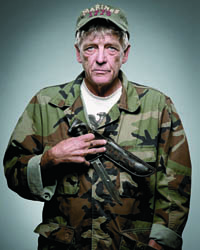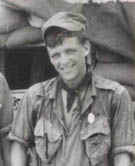
July 2, 1967, was the single worst day for Marines in Vietnam: 84 dead, 190 wounded, nine missing. It began a 13- day battle, Operation Buffalo, that had all the worst aspects of war—body mutilation, trench warfare, massed artillery. Thousands against thousands. One afternoon, the NVA dropped about 1,400 rounds on our area. A few people just refused to fight. We had one guy who wouldn’t do it no more. I mean, when you’re up against 4,000 to 5,000 North Vietnamese and we were probably outnumbered 3-to-1 to begin with.
When I decided to join the Marines in 1965 at 18, I just figured it’s the thing to do. My older brother was in the Marines, right after Korea. I had five uncles in World War II, one who was a Marine. After I did my infantry training at Camp Pendleton, they picked 15 of us to go to Coronado for Naval Gunfire Forward Observer (FO) School. That was my MOS.
We flew into Da Nang and joined up with the 9th Marines at Hill 55, and then Marble Mountain. In May 1966, we went with 1st Battalion, 3rd Marines, into Da Nang to protect civilians during the uprisings when Buddhists were burning themselves up. I got wounded on May 21, spent time in a hospital and didn’t return to Vietnam until early July.
In July I was with the 4th Marines, and we began Operation Hastings, a big multi-battalion operation to clear the DMZ. That’s when we ran into the NVA for the first time. They were using war tactics, flank and motion; it turned into a different war.
Things really heated up in early 1967. I was with the 1/3 then, and in April we went on an LPH (landing platform, helicopter), cruising up and down the coast. In any hot spots, we’d go in with five helos, take care of business—we could be out for over a month.

We pulled our first operation in May 1967, and from there it was just one after another. Four to five thousand NVA at a time would cross the Ben Hai River, which divided North and South Vietnam. After my naval gunfire liaison officer, Ensign John W. McCormick, got killed on May 18, at the beginning of Operation Beau Charger, I was the only FO left. I was an E4 corporal, and it was stressful doing an officer’s job, taking coordinates, determining what round to fire, what spotting round, etc.
The NVA 90th Regiment, 324-B Division was our adversary. Its troops were the best North Vietnam had. We fought them three different times and sent them back across the river. The 1st Battalion, 9th Marines—the Walking Dead, they were called—were running patrols from Con Thien north across the McNamara Line—a 600-meter-wide bulldozed strip we called the Trace—up into the DMZ to stop the enemy.
On July 2, during a two-company patrol about a mile east of Con Thien, the 1/9 walked into a major ambush. They were attacked with massed artillery, mortars, everything, even flamethrowers, which the North Vietnamese were using for the first time.
We had just returned from an operation and were on the LPH when we heard that the 1/9 got hit hard. That evening a gunny sergeant came down to our quarters. “You’re going in tomorrow,” he said. “And don’t forget to write home tonight, because we’re probably not coming back.” That started Operation Buffalo.
On July 3, we made a forced march up to the Trace, an eerie black-and-white world. Everything was burnt from Agent Orange, and human bones and debris littered the ground, as well as dead bodies.
We set up in agricultural trenches alongside 3/9, which had arrived ahead of us. It took us two to three days to remove the dead and wounded, and the enemy continued to barrage us with thousands of rounds. I called in naval gunfire, whatever was available to me. In the meantime, the 2/3 had come in behind us.
Finally, I’m talking to this air spotter in a Bird Dog. “Be advised,” he said, “I just counted 3,000 to 5,000 more NVA crossing the river.” I was with this kid from Michigan we called “Moose.” “What are we gonna do?” Moose says. I told him, “We’re gonna kill as many as we can before they kill us.”
So we pushed up the sand in front of us and put the cleaning rod together, because I knew my M-16 was going to jam. You could hear the enemy mortar shells coming out of the tubes. Word came to withdraw, and we got back and set a big ambush, but the enemy never came across the Trace. Because we had annihilated them. The air spotter reported seeing 200 dead in a trench. And they all had our gear on—flak jackets, American helmets, PRC-25 radios. By the end of the operation, July 14, we had killed almost 1,300 NVA, for 159 Marines and Navy corpsmen killed and 345 wounded. Navy ships had fired something like 1,500 rounds.
When I got home, my dad had to sign so I could buy a pistol, because I wasn’t 21 yet. In Vietnam, I carried two, pulled 16 major operations, 16 assaults. I extended my tour three months and didn’t even take R&R in 16 months. Being there, as the point of the spear, that’s the only way I would have had it. If you’re gonna be a bear, be a grizzly.
From the documentary Wisconsin Vietnam War Stories, by Wisconsin Public Television, www.wisconsinstories.org/vietnam.




